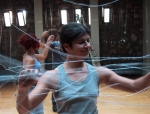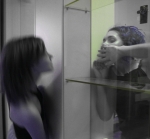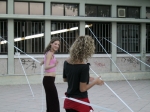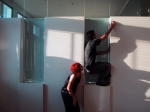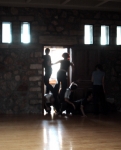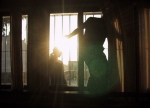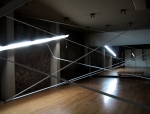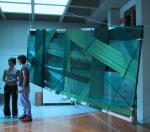σημεία συνάντησης αρχιτεκτονικής + χορού
Ένα workshop για φοιτητές Αρχιτεκτονικής, Design και Χορού που πραγματοποιήθηκε στο Κέντρο Μελέτης Χορού Ισιδώρας και Ραϋμόνδου Duncan στην Αθήνα.
Σχεδιασμός προγράμματος, θεωρητική διδασκαλία: Μανώλης Ηλιάκης
Καλλιτεχνική διεύθυνση: Πηνελόπη Ηλιάσκου
Διδασκαλία κίνησης: Μπέτυ Δραμισιώτη, χορεύτρια, καθηγήτρια χορού.
Θεωρητική υποστήριξη: Έβελυν Γαβρήλου, αρχιτέκτονας.
Σύμφωνα με τον Piaget (1967) η αντίληψη και η διαίσθηση του χώρου δεν προκύπτει μόνο από την παρατήρηση των πραγμάτων, αλλά και από τις ενέργειές μας σε σχέση με αυτά.
Στην πρωτοποριακή αρχιτεκτονική έκφραση των τελευταίων δεκαετιών παρατηρείται μια αμφισβήτηση της παραδοσιακής σχέσης του σώματος με το χώρο.
Η ρευστότητα της σύγχρονης κοινωνίας ενισχύει την κινητικότητα του σώματος μ’ έναν ιδιαίτερα επαναστατικό - χορογραφικό τρόπο, επηρεάζοντας τον τρόπο σκέψης μας. Τη νέα αντίληψη περί χώρου και σώματος επεξεργάζεται δημιουργικά ένα μεγάλο μέρος της σύγχρονης χορογραφίας, βοηθώντας στην κατανόηση όλων αυτών των φαινομένων.
Αξίζει να σημειώσουμε χαρακτηριστικές συνεργασίες χορογράφων με αρχιτέκτονες όπως του χορογράφου Fr. Flammand με τους αρχιτέκτονες Zaha Hadid, Jean Nouvel και Diller + Scoffidio, της χορογράφου Sasha Waltz με τον αρχιτέκτονα Thomas Schenk.
Το εκπαιδευτικό πρόγραμμα που πραγματοποιήθηκε στο Κέντρο Μελέτης Χορού Ισιδώρας και Ραϋμόνδου Duncan, προσπάθησε να κάνει κατανοητό, όχι μόνο σε θεωρητικό επίπεδο, ότι η αντίληψη του χώρου δεν σχετίζεται μόνο με αυτό που βλέπουμε (μια στατική εικόνα) αλλά και με αυτό που ακούμε, που αισθανόμαστε, ή που γευόμαστε. Ο τρόπος που κινούμαστε στο χώρο σε συνδυασμό με τις αισθήσεις μας, αποτελεί ένα ζωντανό σύνολο πραγμάτων και καταστάσεων που εκφράζονται μέσα από την αρχιτεκτονική σκέψη και πράξη.
Στο σύντομο χρονικό διάστημα των 6 ημερών ολοκληρώθηκε μια πρώτη διερευνητική διαδικασία κατανόησης της δομής και της κλίμακας του κτιρίου και του χώρου που το περιβάλλει, σε σχέση με την πορεία και τη στάση του σώματος. Γεννήθηκαν κινητικές ασκήσεις προκειμένου να ενεργοποιηθούν οι αισθήσεις που συνδέουν το σώμα με το αρχιτεκτονικό περιβάλλον. Αρχικές παρατηρήσεις για την διάδραση της ανθρώπινης κίνησης με το κτίριο και τον τρόπο που το σώμα γεννά γεωμετρικές σχέσεις στο χώρο, καταγράφηκαν με τη βοήθεια της ψηφιακής τεχνολογίας και την εικαστική ματιά των φοιτητών του μεταπτυχιακού τμήματος της Α.Σ.Κ.Τ..
Στο ίδιο διάστημα πραγματοποιήθηκαν θεωρητικές διαλέξεις και συζητήσεις σχετικά με τη σύνδεση της Αρχιτεκτονικής και του Χορού. Εντοπίστηκε η σχέση που αναπτύσσεται μεταξύ του δομημένου χώρου και του σώματος. Έγινε παράθεση θεωριών και φιλοσοφικών στοχασμών που αναλύουν τη σχέση αυτή. Αναλύθηκε η αλληλεξάρτηση που αναπτύσσεται μεταξύ της αρχιτεκτονικής και του χορού τον 20ου αιώνα. Παρουσιάστηκαν παραδείγματα συνεργασιών αρχιτεκτόνων με χορογράφους, - εντοπίστηκαν κοινές μέθοδοι σύνθεσης στις δύο Τέχνες. (Κοινές επιρροές από θεωρίες και πρακτικές σύνθεσης).
Ο σχεδιασμός και η υλοποίηση απλών κατασκευών βοήθησαν στη διερεύνηση της σχέσης του χώρου και του σώματος. Η επεξεργασία της δομής και της μορφής τους είχε στόχο ν’ αλλάξει την καθιερωμένη εικόνα του χώρου και της κίνησης σε αυτό. Ο αποκλεισμός της συμβατικής κίνησης και η διακοπή των τυπικών πορειών σε κάποια σημεία τόσο στον εσωτερικό όσο και στον εξωτερικό χώρο του Κέντρου ήταν μια απλή προσέγγιση στο θέμα.
Οι φοιτητές δούλεψαν σε τρεις ομάδες, σε τρία σημεία που επιλέχτηκαν ύστερα από τη «σωματική ανάγνωση» όλων των χώρων του Κέντρου. Στην κίνηση και στην κατασκευή των επεμβάσεων συμμετείχαν σπουδαστές και από τους δύο χώρους. Τα πιο ενδιαφέροντα σημεία του workshop ήταν οι στιγμές που οι ρόλοι των αρχιτεκτόνων και τον χορευτών αντιστρέφονταν.
Η έβδομη - τελευταία μέρα του workshop ήταν ανοιχτή στο κοινό. Παρουσιάστηκαν τα πρώτα δείγματα αυτής της ερευνητικής διαδικασίας, με στόχο να υπάρξει εξέλιξη στο μέλλον. Στην κινητική δράση που προέκυψε - στην οποία είχαν ισότιμο ρόλο με τους χορευτές, οι σπουδαστές αρχιτεκτονικής και Design – δεν υπήρχε καμία πρόθεση χορογραφικής σύνθεσης (ο χρόνος δεν επαρκούσε για κάτι τέτοιο). Η κίνηση ήταν ένα αρχικό και ίσως «φοβισμένο» καταστάλαγμα της βιωματικής εμπειρίας στο κτίριο και στον γύρω χώρο.
Συμμετέχοντες
επέμβαση 1
Γρηγόρη Κρυσταλλία, χορεύτρια, Ζήνδρου Ιουλιέτα, αρχιτέκτονας, Θεωνά Λιάνα, αρχιτέκτονας,
Καλλίτσης Φοίβος, αρχιτέκτονας, Ντώνιας Δημήτρης, Designer.
επέμβαση 2
Γουζέλη Χριστίνα, χορεύτρια, Κατσαρού Σύλβια, χορεύτρια, Πολυξά Μαρία, Designer.
επέμβαση 3
Βουδούρη Γεωρία, αρχιτέκτονας, Κολοβού Έφη, χορεύτρια, Μπασδέκα Χρυσάνθη, χορεύτρια, Στυλιανίδη Αθηνά, αρχιτέκτονας.
Φοιτητές της Α.Σ.Κ.Τ. δούλεψαν στα σημεία 1 + 2:
Αναγνώστου Ρούλα, Κωνσταντινίδης Λεωνίδας, Κωνσταντίνου Γιάννης, Κακουλίδη Αλίκη, Μαραγκάκη Εύα, Παπαδοπούλου Γιούλα, Πεσλή Μαρία, Σάββα Ανδρέας.
“meeting points of architecture + dance”
A workshop for students of Architecture, Design and Dance which took place in the Isadora and Raymond Duncan Centre for Dance Research in Athens.
With the attendance of post-graduate students of the “Digital Forms of Art” MA from the Athens School of Fine Arts
Workshop planning: Manolis Iliakis, Architect-Spatial Designer
Art Direction: Penelope Iliaskou
Movement instruction: Betty Dramissioti, dancer, dance teacher
Theory assistant: Evelyn Gavrilou, architect
According to Piaget, perception and sense of space results not only from the observation of things, but through our actions in relation to them. A questioning of the traditional relationship between body and space has become evident in leading architectural expression in recent decades. The fluidity of contemporary society complements the mobility of the body in a particularly revolutionary, choreographic way that influences the way we think. A great deal of modern choreography makes creative use of this new perception of space and body, thereby promoting greater understanding of such phenomena.
It is worth taking note of characteristic instances of collaboration between choreographers and architects, like that between Fr. Flammand and architects Zaha Hadid, Jean Nouvel and Diller + Scoffidio, and that between the choreographer Sasha Waltz and architect Thomas Schenk.
The educational programme which was conducted at the Isadora and Raymond Duncan Centre for the Study of Dance aimed to make it clear, at more than just a theoretical level, that our perception of space does not relate only to what we see (a static image) but also to what we hear, feel and taste. The way we move in a space combines with our senses to produce a living totality of things and situations which find expression through architectural thought and deed.
The short, six-day period saw the completion of the first exploratory process of understanding how the structure and scale of a building and its surroundings relate to the course and stance of the body. Exercises in movement were created with a view to activating the senses that link body and architectural environment. Initial observations of the way the human body interacts with the building and how the body develops geometrical relations with space were recorded using digital technology and the artistic eye of the students at the University College of Fine Arts Department of Postgraduate Studies.
During the same period lectures and discussions were held on the link between Architecture and Dance. The relationship that develops between a building and the human body was established. Theories and philosophical thought analysing this relationship were juxtaposed. The interdependence which developed between architecture and dance in the 20th century was analysed. Examples were presented to show how architects and choreographers work together. Methods of composition which both Art forms share were pinpointed (shared theoretical influences and practice in composition).
The design and actual building of simple structures helped in the exploration of the relationship between space and the human body. Practical work on structure and form was aimed at changing the conventional picture of space and movement within it. Making conventional movement impossible and interrupting typical movement in certain places both inside and outside the Centre was one simple approach to the subject.
The students worked in three groups, in three places that were selected after a “body reading” of all areas in the Centre. Students of both disciplines were involved in the movement and construction of the “interventions”. The most interesting moments in the workshop came when architects and dancers exchanged roles.
The seventh – and last – day of the workshop was open to the general public. The initial findings of the exploratory procedure were presented, with further development in the future in mind. In the movement activity which followed – in which the students of architecture and design were equally as active as the dancers – there was no intention to choreograph a link (there was not enough time for such an activity). The movement was the initial, and perhaps “hesitant”, outcome of the hands-on experience of the building and its surroundings.
Those involved in this educational process hope that investigation in this area continues, so as to explore the way awareness of the body, and intervening in what it takes for granted, awakens sensitivity to the space and time surrounding it.
They also hope to enhance existing methods of choreographic composition which relate to this field of study, so as to help young choreographers develop a particularly fluid vocabulary.
They are, therefore, trying to organise another workshop for dancers and architects, which will be in the form of an exploratory workshop. They are seeking people in Hellas and the rest of Europe who would be interested in making a contribution to this effort.



